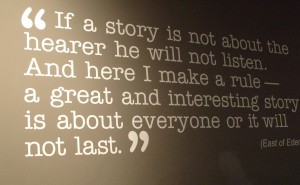Just One Tip from 11 Great Storytellers
I am on overload. You’re on overload. We’re all feeling it. So instead of the usual list of 100+ tips (who has time?!), I asked some of my smart, fun, storytelling friends in b2b, b2c, podcasting, television, video, etc. to give their one best, practical storytelling tip.
Here are 11 tips (one each) from 11 people who tell a lot of stories. If you just implement a few of these, you – and your audience – will feel the difference.
So take your storytelling to 11 with just one tip! Well, 11 of them!

Image source: Torley cc by 2.0
Phil Mershon, Director of Events, Social Media Examiner
See Phil’s storytelling tip…it’s almost like being on a real roller coaster!
Kevin Allison, Host of storytelling podcast RISK! and Founder of The Story Studio
“Pick a particularly emotional moment in your life and remember what you saw, heard, smelled, tasted, felt in your body, said in your head or said out loud right then.”
Bryan Kramer, Author of “Shareology,” President & CEO PureMatter
“Remember that are five basic elements to a good story:
Characters: The best tales have at least two characters
Content: This refers to who, what, when, and where.
Motivations: The reason behind the actions of the characters
Conflict: The juiciest part of the story.
Resolution: The realization, epiphany, or takeaway
Ultimately the why should reflect a call to action. The story leading to this conclusion should provide customer with an emotional reason in which to take the next step in the sales cycle.”
image source: Jill Clardy CC by 2.0
Ron Ploof, Creator of The StoryHow™ PitchDeck
“While most stories are told from beginning to end, they’re developed the other way around. Master storytellers decide on an ending and then plot an intentional course toward it.”
David Nihill, Author, Comedian, Co-Founder, FunnyBizz Conference
“Make it funny! The human mind is hardwired to appreciate story and there is only one thing folks love more than a good story: a good funny story. When crafting these stories pay attention to the wise words of Alan Weiss: “The safest humor involves personal stories, because they are guaranteed to be original and unheard, they can be practiced and perfected, and they are highly personalized to your style.”
Martin Shervington, Speaker, Marketer, Founder of PlusYourBusiness
“Every post we now make on social media can be a ‘page’ in the story, every week we create a chapter, and every few months we write a book – all interactive, all engaging and all including the members of the community we serve.”
Rebecca Stockley, Founding Member BATS Improv, Owner of Improv Lady
“Ask yourself what you really, really want your audience to know or do, then ask yourself again. Use specific images to bring your story to life, and start and end with your key message. Super Story Secret: Vulnerability connects with more resonance than heroism!”
Karen Dietz, Author “Business Storytelling for Dummies,” Founder of Just Story It
“PAUSES!! When we share a story we are usually so excited to tell it that we often just run right on through it. Yet dramatic tension — and the attention of your audience — is mega-magnified when you insert a pause at key places. There can be humorous pauses i.e taking a breath with a twinkle in your eye before saying something funny, or serious pauses just before you deliver a profound message. Pausing takes practice, and is fun to play with.”
Brian Carter, Author ‘Facebook Marketing,” “The Like Economy,” and co-author of “The Cowbell Principle,” digital marketing strategist, Brian Carter Group
“Start your story in the middle of some exciting action- a problem or crisis. Try to avoid just listing things that happened. Instead, use dialogue (especially conflict between characters, which is very interesting!) to create scenes and describe things in terms of the five senses.”
Amy Harrison, Content Marketer, Founder HarrsionAmy.com: Say no to boring content!
“Every great story has some tension and then release and resolution. A perfect place to start? Your customer’s challenges or tensions and the happy resolution you bring to them.”
Kathy Klotz-Guest, Speaker, improviser, author, Chief Storyteller of Keeping it Human, Creator of ‘Confessions of a Lifelong Shit-Disturber’ (a One-Woman Show)
“Most business storytelling is superficial. Go deeper. Be open about challenges your business is having. That means forget perfect resolutions / story endings. Perfect is boring and unrealistic. Life is messy. Invite your audience to co-create a better ending with you.”
Your Turn!
What’s your best storytelling tip you’d like to share? How do you take your storytelling to 11? Let us know in the comments below!



